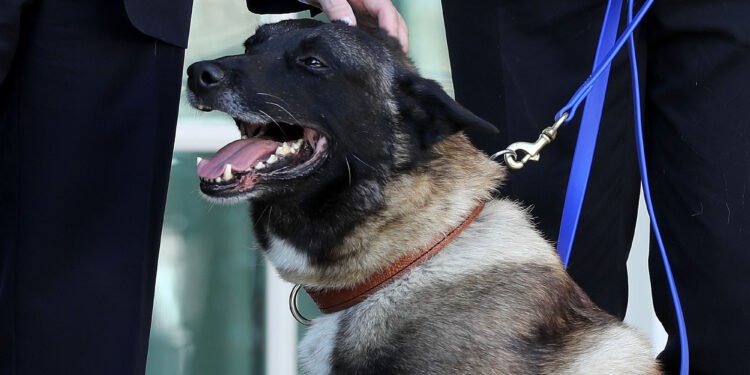Belgium (Brussels Morning newspaper), With all the contentious issues facing the United States these days, this dialogue on the Senate floor hardly seems newsworthy. It was not front-page news.
Speaking as a member of the Armed Services Committee, Senator Richard Blumenthal (Democrat, Connecticut) pushed for more “domestically raised and trained military and police working dogs” in an effort not only to trim budgets but also to “buy American.”
Blumenthal wants the Defense Department to establish a more effective military/police canine breeding and training program on American soil. The Senator argued that military and police departments have turned to European nations (including Belgium !) for the task of securing the best dogs for the highly specialized assignments required by the American military and police.
The cost to properly train and breed these dogs is skyrocketing with some estimates as high as $150,000 per animal. Few American breeders are up to the task. He noted that all four branches of the military (Army, Navy, Air Force, and Marines) use canines for such vital tasks as bomb detection, sentry guarding, patrols, tracking, and attack. Similarly, police departments across the country use specifically trained canines for drug detection, subduing criminals, and search and rescue. Their work is invaluable and it is no wonder that these dogs are a precious resource.
The questions remain: What makes Belgian dogs among the most sought after for military and police dogs? Why is Belgium’s training and breeding methodology of canines some of the best in the world? What is Belgium doing that the United States is not? Consider…
Dogs in warfare and policing have a long European history starting in ancient times.
“War Dogs” were used by the Greeks, Slavs, Britons, and Romans. Police dogs have also been used in police work for centuries with the first recorded use of police dogs at the port of Antwerp Belgium where dogs were used to guard docks, piers, and warehouses. Later they were trained to track, guard, and intimidate criminals.

With its centuries-old traditions of breeding and training, Belgian dog handlers are the gold standard for excellence. The reasons are many. Belgian trainers and breeders are strictly merit-based. They breed for ability with little consideration for form.
Conversely, American breeders have tended to stress morphology— the shape, size, and bone structure— over behavior, independent thought, skill, and single-minded purpose. The American Kennel Club (AKC) is often criticized for demanding strict “body types” as opposed to those dogs that best perform on the battlefield or on the streets.
Additionally, American breeders balk at the idea of “culling” litters believing that their breed standards best serve market demands. Belgian breeders however have long stressed the animal’s skill, intelligence, ability, and achievement over beauty and looks.
Different breeds have been used by the military and police for different roles. Dogs have been trained for very specific tasks: tracking, bomb detection, scouts, messengers, search and rescue, sentry guarding, and attack. Belgium Shepards for example, have long been the benchmark standard for the most reliable, intelligent, loyal, and resilient dogs for this type of work.
Belgian Shepherds are a breed of four distinct varieties: the Groenendael, and Laekenois. Malinois and Teruren. Most of the world, including Belgium, considers Belgian shepherds to be one breed.
Unfortunately, the American Kennel Club (AKC) has decided that the four variants should be considered four separate entities. This has resulted in a smaller gene pool, instead of one large one. Larger gene pools are much preferred for genetic diversity— an attribute so important for long-term health, vigor, and training viability.
A recent study by the University of Namur and the Veterinary Service of the Belgian Defense examined the relationship between the methodology of handlers, the performance of military working dogs (MWD), and the welfare of the animals. The survey of over 300 Belgian MWD handlers was the most comprehensive to date in evaluating the relationship between “reward and aversive punishment” training methods.
The evaluations were in-depth —examining such subjects as the dog’s baseline for distraction, levels of concentration, a dog’s posture, and body language. The purpose of the analysis is to better understand the usefulness of new and evolving training systems and what changes might improve the dog/handler relationship.
Compare this example to the United States where dog training and what constitutes a “dog trainer” is completely unregulated. There are no standards, no certifications, and background checks.
In his argument to improve domestic dog breeding and training, Senator Blumenthal never mentioned Belgium by name on the Senate floor. When you consider that only 10% of military/police working dogs are bred domestically and that the rest are purchased from overseas (read: Belgium), Blumenthal’s argument for improved domestic canine breeding and training programs may in fact be valid.
Did You Know?
— The police department in Ghent, Belgium (1899) was the first to introduce an organized police dog breeding and training program.
— In 2019 the United States Postal Service issued a commemoration stamp to honor the Belgian Malinois.
— Conan, a Belgian Malinois, served in over 50 combat missions for the special operations unit of the US Army. He took place in the various ISIS raids most notably the Barisha raid. There, he chased Abu Bakr al-Baghdadi into a tunnel where the terror leader detonated his suicide vest. Conan was injured but recovered and returned to field duty shortly thereafter which resulted in the demise of more suspected terrorists. Likewise, Chips, a Belgian Shephard was the most decorated dog in World War Two. In one instance he single-handedly flushed out a four-man enemy machine gun nest leading to their surrender.
— So endemic is the European influence in American canine training that German, rather than English, remains the language of choice when giving commands.




